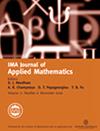Numerical continuation of spiral waves in heteroclinic networks of cyclic dominance
IF 1.4
4区 数学
Q2 MATHEMATICS, APPLIED
引用次数: 1
Abstract
Heteroclinic-induced spiral waves may arise in systems of partial differential equations that exhibit robust heteroclinic cycles between spatially uniform equilibria. Robust heteroclinic cycles arise naturally in systems with invariant subspaces, and their robustness is considered with respect to perturbations that preserve these invariances. We make use of particular symmetries in the system to formulate a relatively low-dimensional spatial two-point boundary-value problem in Fourier space that can be solved efficiently in conjunction with numerical continuation. The standard numerical set-up is formulated on an annulus with small inner radius, and Neumann boundary conditions are used on both inner and outer radial boundaries. We derive and implement alternative boundary conditions that allow for continuing the inner radius to zero and so compute spiral waves on a full disk. As our primary example, we investigate the formation of heteroclinic-induced spiral waves in a reaction–diffusion model that describes the spatiotemporal evolution of three competing populations in a 2D spatial domain—much like the Rock–Paper–Scissors game. We further illustrate the efficiency of our method with the computation of spiral waves in a larger network of cyclic dominance between five competing species, which describes the so-called Rock–Paper–Scissors–Lizard–Spock game.循环优势异斜网中螺旋波的数值延拓
异斜诱导的螺旋波可能出现在空间均匀平衡之间表现出鲁棒异斜循环的偏微分方程系统中。鲁棒异宿环在具有不变子空间的系统中自然产生,并且它们的鲁棒性考虑了保持这些不变性的摄动。我们利用系统中特定的对称性,在傅里叶空间中构造了一个相对低维的空间两点边值问题,该问题可以结合数值延拓有效地求解。标准的数值设置是建立在一个小的内半径环空上,诺伊曼边界条件被用于内外径向边界。我们推导并实现了允许内半径连续为零的替代边界条件,从而计算了整个磁盘上的螺旋波。作为我们的主要例子,我们在反应扩散模型中研究了异斜诱导的螺旋波的形成,该模型描述了三个竞争种群在二维空间域中的时空演化,就像石头剪刀布游戏一样。我们进一步说明了我们的方法的效率与螺旋波的计算在一个更大的网络循环优势之间的五个竞争物种,这描述了所谓的石头-剪刀-布-蜥蜴-斯波克游戏。
本文章由计算机程序翻译,如有差异,请以英文原文为准。
求助全文
约1分钟内获得全文
求助全文
来源期刊
CiteScore
2.30
自引率
8.30%
发文量
32
审稿时长
24 months
期刊介绍:
The IMA Journal of Applied Mathematics is a direct successor of the Journal of the Institute of Mathematics and its Applications which was started in 1965. It is an interdisciplinary journal that publishes research on mathematics arising in the physical sciences and engineering as well as suitable articles in the life sciences, social sciences, and finance. Submissions should address interesting and challenging mathematical problems arising in applications. A good balance between the development of the application(s) and the analysis is expected. Papers that either use established methods to address solved problems or that present analysis in the absence of applications will not be considered.
The journal welcomes submissions in many research areas. Examples are: continuum mechanics materials science and elasticity, including boundary layer theory, combustion, complex flows and soft matter, electrohydrodynamics and magnetohydrodynamics, geophysical flows, granular flows, interfacial and free surface flows, vortex dynamics; elasticity theory; linear and nonlinear wave propagation, nonlinear optics and photonics; inverse problems; applied dynamical systems and nonlinear systems; mathematical physics; stochastic differential equations and stochastic dynamics; network science; industrial applications.

 求助内容:
求助内容: 应助结果提醒方式:
应助结果提醒方式:


